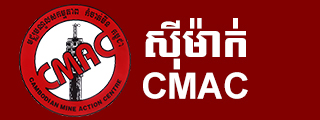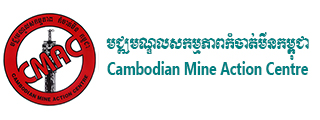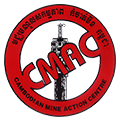CMAC’s Tools
Mobile Platoon: 20
Mine Detection Dog Teams (short leash): 13
Mine Detection Dog Teams (long leash): 02
UXO Detection Dog Teams (EDD): 02
Improvised Explosive Dog Team (IDD): 01
Brush Cutter Teams (BC): 23
Demining Machine Teams (DM): 09
Battle Area Clearance Teams (BAT): 04
Battle Area Clearance by Village (BAV): 14
Explosive Ordnance Disposal Teams (EOD): 30
Mine/UXO Risk Education (MRE)
Community Based Mine Risk Reduction (CBMRR): 28
Community Based UXO Risk Reduction (CBURR): 18
Mine/UXO Field Information And Survey
Technical Survey Team (TSC): 27
Path Finding Teams: 06
CMAC- Mine/ERW Tools
Mine/ERW contamination in Western, North and Northwestern parts of the country still poses as a major thread. It is there where most of the CMAC clearance assets were deployed (Demining Unit [DU] 1, DU2, DU3, DU4, DU6). In Eastern parts of the country (DU3 and DU5) where the thread came mostly from ERW contamination, CMAC operations has suffered from severe cut back due to delayed funding from the United States. DU4 whose activities support clearance of north and central parts of the country has also experienced funding difficulty and resulting to limited operations. Contract demining has assisted in employing some small demining assets. Their works were to support infrastructure and development projects.
In general, this first six months of 2011 has been the worse six months for operations since its funding crisis experienced in year 2000.
However, despite of this funding difficulty, CMAC has made reasonable effort to spread its assets to response to the needs of the national and local government, and the mine/ERW affected communities (as CMAC deployment map of June 2011).
At the start of the 2011 IWP, a number of team was planned for deployment (IWP 2011, Page 21-22). Using number of team/month for each tool, the first six months deployment result was recorded as far less than plan, another word each of CMAC operation teams were deployed in less time than originally planned; except the TSC. Planned versus actual team deployed shows a comparison between planned team/month and actual deployed team/month. This low performance was attributed to lack and delayed funding.
Survey
Baseline Survey (BLS) activities which has started since the mid- 2009 have been very successful. Funding to support survey operation came from bi-lateral and UNDP funding scheme. By the end of the first quarter 2011, funding from UNDP, USA, German ceased and the bulk of CMAC BLS activity have been reduced; however, with assistance from NPA CMAC turns six of its survey teams to focus on the long overdue ERW survey. This survey activity will complement the national BLS effort. The focus is to survey on the Eastern provinces and will continue well into 2012. The result of this survey has been limited as the teams were in training and participating in cluster munitions related clearance.
Clearance – Land Release
Land Release (LR) historically was considered as part of the survey. It will eventually be grouped with clearance. This methodology is in full compliance with the Cambodian Mine Action Standard (CMAS 15); it allows CMAC to release land through Non-Technical Survey, Technical survey and clearance.
At the beginning of the year (2011), CMAC aimed to fully implement LR in all of its projects. This effort has however faced many difficulties.
Firstly, there was a delay in implementing the project formerly known as UNDP Clearing for Result (CFR) which calls for full application of LR process resulting in team standing down.
Secondly, after CFR agreement has been made with the CMAA, a large amount of funding have not been awarded to CMAC. This also resulting in team standing down and team restructured and rearranged which require more training.
Thirdly, projects other than the CFR require more training on the LR process.
By June 2011, only teams assigned to the CFR projects and some teams supported under the Counterpart project have implemented LR; the result of the first six month reflects these constraints.
Introducing new methodology is a change which must be properly managed to ensure there will be a change in the ways the clearance and survey works will get done. Team leaders and members as well as the management team need to have good confidence in the new way. The application of LR is a change management in the process and will take time to mature. The initial result of LR application was satisfactory and was acceptable by the CMAA and positively commented by the GICHD.
Effort to bring other teams in line was slow due to competing demand; however, many orientations have been initiated through training and workshops organized by the Planning and Operation Department.
In term of productivity achieved, the IWP (2011, Page 21-22) has set a new average target for land release for each of the CMAC clearance tool. In general, actual productivity combine for this first six months was lower comparing to plan. This was obvious due to many teams were not deployed (Productivity: Plan V/S Actual from January to June 2011). The border conflict with Thailand has also impacted on team productivity especially those assigned to operate along the northern border.
To be more specific:
- March 2011: CMAC-HIB project at DU5 with 41 staff was placed on stand down
- March 2011: CMAC-US project at DU3 and DU5 with 263 staff was placed on stand down
- April 2011: Grassroot project at DU4 with 113 staff placed on stand down
- April 2011: CFR at DU1, 2, 4 along with BLS team with 254 staff was place on stand down
- May 2011: World Bank project at DU5 with 62 staff was placed on stand down
However, comparing to the average productivity per team/month (Average productivity: Planned V/S Actual), land release under the landmine category has been about the same for some tools, but lower for others. Under the BAC clearance, the actual productivity was far better than the plan.
This low average productivity can be attributed to the stop and go operations due to insecurity at the border area. It could be also be from other technical attribution. Areas where key concerns are BC, CMC and DM team productivity. Attempt will be made in the second six months to assess the causes of low productivity and make effort to improve them.
Table and Chart 3 below provide an illustration of the average productivity per team per month comparing to the target productivities set under the IWP 2011.
Note that BAC tools (BAV, ERC, BAT, CBAT) have performed far better than planned targets. An assessment would have to be done so to reflect into next year target productivities.
During this reporting period many demining tools have been integrated to better response to the going minefield environment with the aim to improve productivity. Integrations were seen when team such as MDD combine with BC, BC with MP, MP with MDD, TSC with other tools, etc.
In term of project management, the Planning and Operations Department has managed to oversee 35 small and large projects (Summarizes project management matrix).
Comparison to last year
Despite of Land Release effort to speedily release land for productive use, the progress in the first six months is very low comparing to the same period in 2010.
According to the 2011 Work Plan (full year work plan), CMAC aimed to clear 61,764,000m² of both prioritized areas in minefields and BAC fields through the PMAC/MAPU process and other development requirement. Of this projected clearance, 51,300,000m² was set to target mine contaminated area and 10,464,000m² was set to target BAC area. It also envisaged to response to 10,000 EOD calls requested by the communities.





